Class 9 - Mathematics
Quadrilaterals - Exercise 8.1

Top Block 1
Exercise 8.1
Question : 1: The angles of quadrilateral are in the ratio 3: 5: 9: 13. Find all the angles of the quadrilateral.
Answer :
Let the common ratio between the angles be x. Therefore, the angles will be 3x, 5x, 9x, and
13x respectively.
As the sum of all interior angles of a quadrilateral is 3600,
⇒ 3x + 5x + 9x + 13x = 3600
⇒ 30x = 3600
⇒ x = 3600/30
⇒ x = 120
Hence, the angles are
3x = 3 * 120 = 360
5x = 5 * 120 = 600
9x = 9 * 120 = 1080
13x = 13 * 120 = 1560
Question : 2: If the diagonals of a parallelogram are equal, then show that it is a rectangle.
Answer :

its interior angles is 900.
In ΔABC and ΔDCB,
AB = DC (Opposite sides of a parallelogram are equal)
BC = BC (Common)
AC = DB (Given)
By SSS congruence rule,
ΔABC ≅ΔDCB
So, ∠ABC = ∠DCB
It is known that the sum of measures of angles on the same side of traversal is 1800
∠ABC + ∠DCB = 1800 [AB || CD]
⇒ ∠ABC + ∠ABC = 1800
⇒ 2∠ABC = 1800
⇒ ∠ABC = 900
Since ABCD is a parallelogram and one of its interior angles is 900, ABCD is a rectangle.
Question : 3: Show that if the diagonals of a quadrilateral bisect each other at right angles, then it is a rhombus.
Answer :
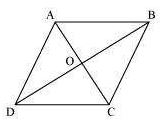
Let ABCD be a quadrilateral, whose diagonals AC and BD bisect each other at right angle i.e.,
OA = OC, OB = OD, and ∠AOB = ∠BOC = ∠COD = ∠AOD = 90º. To prove
ABCD a rhombus, we have to prove ABCD is a parallelogram and all the sides of ABCD are
equal.
In ΔAOD and ΔCOD,
OA = OC (Diagonals bisect each other)
∠AOD = ∠COD (Given)
OD = OD (Common)
So, ΔAOD ≅ΔCOD (By SAS congruence rule)
Hence, AD = CD …………..1
Similarly, it can be proved that
AD = AB and CD = BC ………..2
From equation 1 and 2, we get
AB = BC = CD = AD
Since opposite sides of quadrilateral ABCD are equal, it can be said that ABCD is a
parallelogram. Since all sides of a parallelogram ABCD are equal, it can be said that ABCD is a
rhombus.
Question : 4: Show that the diagonals of a square are equal and bisect each other at right angles.
Answer :
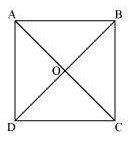
Mddle block 1
Let ABCD be a square. Let the diagonals AC and BD intersect each other at a point O. To prove
that the diagonals of a square are equal and bisect each other at right angles, we have to
prove AC = BD, OA = OC, OB = OD, and ∠AOB = 90º.
In ΔABC and ΔDCB,
AB = DC (Sides of a square are equal to each other)
∠ABC = ∠DCB (All interior angles are of 90)
BC = CB (Common side)
So, ΔABC ≅ΔDCB (By SAS congruency)
Hence, AC = DB (By CPCT)
Hence, the diagonals of a square are equal in length.
In ΔAOB and ΔCOD,
∠AOB = ∠COD (Vertically opposite angles)
∠ABO = ∠CDO (Alternate interior angles)
AB = CD (Sides of a square are always equal)
So, ΔAOB ≅ΔCOD (By AAS congruence rule)
Hence, AO = CO and OB = OD (By CPCT)
Hence, the diagonals of a square bisect each other.
In ΔAOB and ΔCOB,
As we had proved that diagonals bisect each other, therefore,
AO = CO
AB = CB (Sides of a square are equal)
BO = BO (Common)
So, ΔAOB ≅ΔCOB (By SSS congruency)
Hence, ∠AOB = ∠COB (By CPCT)
However, ∠AOB + ∠COB = 1800 (Linear pair)
2∠AOB = 1800
∠AOB = 900
Hence, the diagonals of a square bisect each other at right angles.
Question : 5: Show that if the diagonals of a quadrilateral are equal and bisect each other at right angles, then it is a square.
Answer :
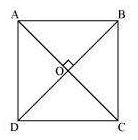
Let us consider a quadrilateral ABCD in which the diagonals AC and BD intersect each other at
- It is given that the diagonals of ABCD are equal and bisect each other at right angles.
Therefore, AC = BD, OA = OC, OB = OD, and ∠AOB = ∠BOC = ∠COD = ∠AOD = 900.
To prove ABCD is a square, we have to prove that ABCD is a parallelogram, AB = BC = CD = AD,
and one of its interior angles is 900.
In ΔAOB and ΔCOD,
AO = CO (Diagonals bisect each other)
OB = OD (Diagonals bisect each other)
∠AOB = ∠COD (Vertically opposite angles)
So, ΔAOB ≅ΔCOD (SAS congruence rule)
Hence AB = CD (By CPCT) ………..1
And, ∠OAB = ∠OCD (By CPCT)
However, these are alternate interior angles for line AB and CD and alternate interior angles
are equal to each other only when the two lines are parallel.
So, AB || CD …………2
From equations 1 and 2, we obtain
ABCD is a parallelogram.
In ΔAOD and ΔCOD,
AO = CO (Diagonals bisect each other)
∠AOD = ∠COD (Given that each is 90º)
OD = OD (Common)
So, ΔAOD ≅ΔCOD (SAS congruence rule)
Hence AD = DC ………..3
However, AD = BC and AB = CD (Opposite sides of parallelogram ABCD)
⇒ AB = BC = CD = DA
Therefore, all the sides of quadrilateral ABCD are equal to each other.
In ΔADC and ΔBCD,
AD = BC (Already proved)
AC = BD (Given)
DC = CD (Common)
So, ΔADC ≅ΔBCD (SSS Congruence rule)
Hence, ∠ADC = ∠BCD (By CPCT)
However, ∠ADC + ∠BCD = 1800 (Co-interior angles)
⇒ ∠ADC + ∠ADC = 1800
⇒ 2∠ADC = 1800
⇒ ∠ADC = 900
One of the interior angles of quadrilateral ABCD is a right angle.
Thus, we have obtained that ABCD is a parallelogram, AB = BC = CD = AD and one of its interior
angles is 900. Therefore, ABCD is a square.
Question : 6:
Diagonal AC of a parallelogram ABCD bisects ∠A (see Fig).

Show that
(i) it bisects ∠ C also, (ii) ABCD is a rhombus
Answer :
(i) ABCD is a parallelogram.
So, ∠DAC = ∠BCA (Alternate interior angles) …………1
And, ∠BAC = ∠DCA (Alternate interior angles) …………2
However, it is given that AC bisects ∠A.
So, ∠DAC = ∠BAC …………..3
From equations 1, 2, and 3, we obtain
∠DAC = ∠BCA = ∠BAC = ∠DCA …………4
⇒ ∠DCA = ∠BCA
Hence, AC bisects ∠C.
(ii)From equation 4, we obtain
∠DAC = ∠DCA
⇒ DA = DC (Side opposite to equal angles are equal)
However, DA = BC and AB = CD (Opposite sides of a parallelogram)
⇒ AB = BC = CD = DA
Hence, ABCD is a rhombus.
Question : 7:
ABCD is a rhombus. Show that diagonal AC bisects ∠A as well as ∠C and diagonal BD bisects ∠B as well as ∠D.

Answer :
Join AC.
In ΔABC,
BC = AB (Sides of a rhombus are equal to each other)
So, ∠1 = ∠2 (Angles opposite to equal sides of a triangle are equal)
However, ∠1 = ∠3 (Alternate interior angles for parallel lines AB and CD)
⇒ ∠2 = ∠3
Therefore, AC bisects ∠C.
Also, ∠2 = ∠4 (Alternate interior angles for || lines BC and DA)
⇒ ∠1 = ∠4
Therefore, AC bisects ∠A.
Similarly, it can be proved that BD bisects ∠B and ∠D as well.
Question : 8: ABCD is a rectangle in which diagonal AC bisects ∠A as well as ∠C. Show that:
(i) ABCD is a square (ii) diagonal BD bisects ∠B as well as ∠D.
Answer :
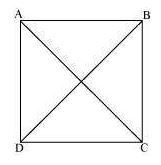
Let ABCD be a parallelogram. To show that ABCD is a rectangle, we have to prove that one of
(i) It is given that ABCD is a rectangle.
So, ∠A = ∠C
⇒ ∠A/2 = ∠C/2
⇒ ∠DAC = ∠DCA [AC bisects ∠A and ∠C]
CD = DA [Sides opposite to equal angles are also equal]
However, DA = BC and BC = CD [Opposite sides of a rectangle are equal]
⇒ AB = BC = CD = DA
ABCD is a rectangle and all of its sides are equal.
Hence, ABCD is a square.
(ii) Let us join BD.
In ΔBCD,
BC = CD (Sides of a square are equal to each other)
∠CDB = ∠CBD (Angles opposite to equal sides are equal)
However, ∠CDB = ∠ABD (Alternate interior angles for AB || CD)
⇒ ∠CBD = ∠ABD
⇒ BD bisects B.
Also, ∠CBD = ∠ADB (Alternate interior angles for BC || AD)
⇒ ∠CDB = ∠ABD
So, BD bisects ∠D.
Question : 9: In parallelogram ABCD, two points P and Q are taken on diagonal BD such that DP = BQ (see the given figure). Show that:
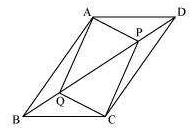
Let ABCD be a parallelogram. To show that ABCD is a rectangle, we have to prove that one of
(i) ∆APD ≅∆CQB (ii) AP = CQ (iii) ∆AQB ≅∆CPD
(iv) AQ = CP (v) APCQ is a parallelogram
Answer :
(i) In ∆APD and ∆CQB,
∠ADP = ∠CBQ (Alternate interior angles for BC || AD) AD = CB (Opposite sides of arallelogram
ABCD)
DP = BQ (Given)
∠∆APD ≅∆CQB (Using SAS congruence rule)
(ii) As we had observed that ∆APD ≅∆CQB,
AP = CQ (CPCT)
(iii) In ∆AQB and ∆CPD,
∠ABQ = ∠CDP (Alternate interior angles for AB || CD) AB = CD (Opposite sides of
parallelogram ABCD)
BQ = DP (Given)
∆AQB ≅∆CPD (Using SAS congruence rule)
(iv) As we had observed that ∆AQB ≅∆CPD,
∠ AQ = CP (CPCT)
(v) From the result obtained in (ii) and (iv),
AQ = CP and AP = CQ
Since opposite sides in quadrilateral APCQ are equal to each other, APCQ is a parallelogram.
Question : 10: ABCD is a parallelogram and AP and CQ are perpendiculars from vertices A and C on diagonal BD (See the given figure). Show that
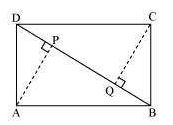
Let ABCD be a parallelogram. To show that ABCD is a rectangle, we have to prove that one of
(i) ∆APB ≅∆CQD (ii) AP = CQ
Answer :
(i) In ∆APB and ∆CQD,
∠APB = ∠CQD (Each 900)
AB = CD (Opposite sides of parallelogram ABCD)
∠ABP = ∠CDQ (Alternate interior angles for AB || CD)
∠∆APB ≅∆CQD (By AAS congruency)
(ii) By using the above result
∆APB ≅∆CQD, we obtain
AP = CQ (By CPCT)
Question : 11: In ∆ABC and ∆DEF, AB = DE, AB || DE, BC = EF and BC || EF. Vertices A, B and C are joined to vertices D, E and F respectively (see the given figure). Show that
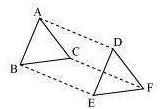
(i) Quadrilateral ABED is a parallelogram. (ii) Quadrilateral BEFC is a parallelogram
(iii) AD || CF and AD = CF (iv) Quadrilateral ACFD is a parallelogram
(v) AC = DF (vi) ∆ABC ≅∆DEF.
Answer :
(i) It is given that AB = DE and AB || DE.
If two opposite sides of a quadrilateral are equal and parallel to each other, then it will be a
parallelogram.
Therefore, quadrilateral ABED is a parallelogram.
(ii) Again, BC = EF and BC || EF
Therefore, quadrilateral BCEF is a parallelogram.
(iii) As we had observed that ABED and BEFC are parallelograms, therefore AD = BE
and AD || BE (Opposite sides of a parallelogram are equal and parallel)
And, BE = CF and BE || CF
(Opposite sides of a parallelogram are equal and parallel)
So, AD = CF and AD || CF
(iv) As we had observed that one pair of opposite sides (AD and CF) of quadrilateral ACFD are
equal and parallel to each other, therefore, it is a parallelogram.
(v) As ACFD is a parallelogram, therefore, the pair of opposite sides will be equal and parallel
to each other.
AC || DF and AC = DF
(vi) ∆ABC and ∆DEF,
AB = DE (Given)
BC = EF (Given)
AC = DF (ACFD is a parallelogram)
∆ABC ≅∆DEF (By SSS congruence rule)
Question : 12: ABCD is a trapezium in which AB || CD and AD = BC (see the given figure). Show that
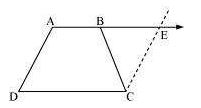
(i) ∠A = ∠B (ii) ∠C = ∠D
(iii) ∆ABC ≅∆BAD (iv) diagonal AC = diagonal BD
[Hint: Extend AB and draw a line through C parallel to DA intersecting AB produced at E.]
Answer :
Let us extend AB. Then, draw a line through C, which is parallel to AD, intersecting AE at point
- It is clear that AECD is a parallelogram.
(i) AD = CE (Opposite sides of parallelogram AECD)
However, AD = BC (Given)
Therefore, BC = CE
Hence, ∠CEB = ∠CBE (Angle opposite to equal sides are also equal)
Consider parallel lines AD and CE.
AE is the transversal line for them.
∠A + ∠CEB = 1800 (Angles on the same side of transversal)
∠A + ∠CBE = 1800 (Using the relation ∠CEB = ∠CBE) ………….1
However, ∠B + ∠CBE = 1800 (Linear pair angles) …………….2
From equations 1 and 2, we obtain
∠A = ∠B
(ii) AB || CD
∠A + ∠D = 1800 (Angles on the same side of the transversal)
Also, ∠C + ∠B = 1800 (Angles on the same side of the transversal)
⇒ ∠A + ∠D = ∠C + ∠B
However, ∠A = ∠B [Using the result obtained in (i)]
⇒ ∠C = ∠D
(iii) In ∆ABC and ∆BAD,
AB = BA (Common side)
BC = AD (Given)
∠B = ∠A (Proved before)
So, ∆ABC ≅∆BAD (SAS congruence rule)
(iv) We have observed that, ∆ABC ≅∆BAD. So, AC = BD (By CPCT)
